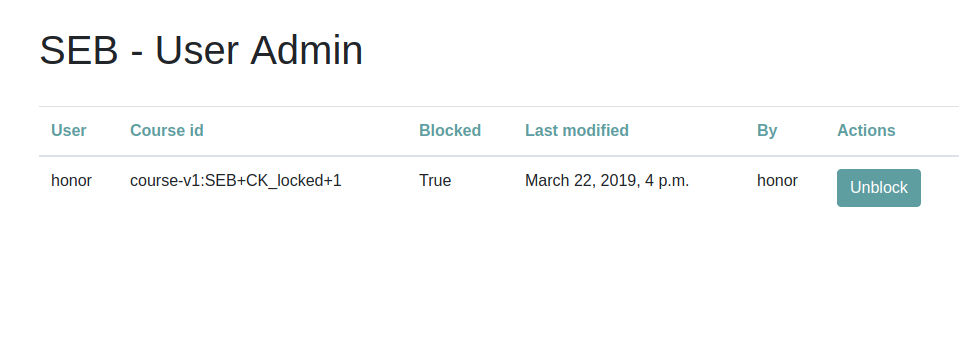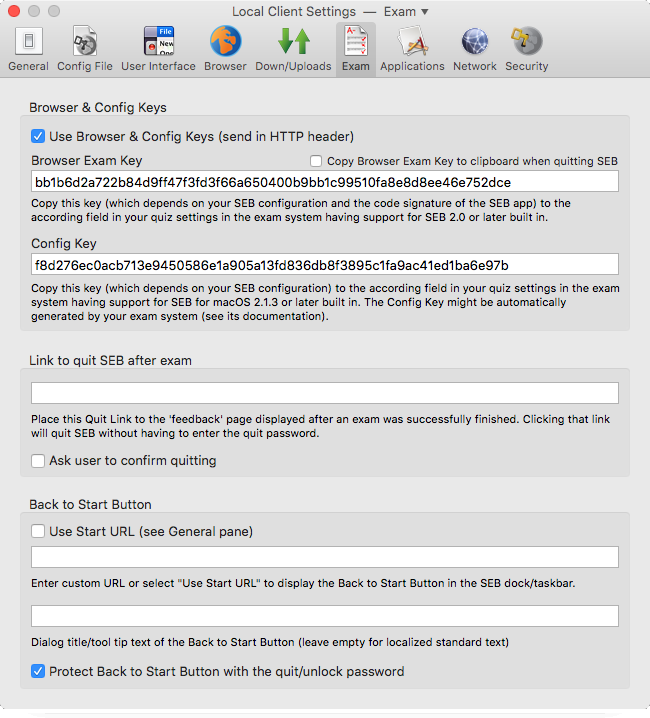Usage and configuration¶
The SEB Open edX plugin is a very flexible plugin and most of its options can be configured.
Plugin Settings¶
The first thing than can be configured is the plugin itself. For this, the plugin works together with the Open edX platform so that the global settings can be defined in the same way every other property in the platform is.
Both for Native or for Devstack environments there is a set of files lms.env.json, cms.env.json, that allow the instance administrators to change the global settings of the plugin.
If you want to modify any of this settings, you need to add a new key inside of the json files for the lms and cms and restart the server.
Example:
to globally modify the available permissions you would modify the
SEB_PERMISSION_COMPONENTS{ ... "SEB_PERMISSION_COMPONENTS": [ "AlwaysAllowStaff", "CheckSEBHashBrowserExamKey", "CheckSEBHashConfigKey" ] ... }
If you are using ansible and the configuration project, then you want to modify the EDXAPP_LMS_ENV_EXTRA and EDXAPP_CMS_ENV_EXTRA variables.
The same change done in ansible:
EDXAPP_LMS_ENV_EXTRA: ... SEB_PERMISSION_COMPONENTS: - AlwaysAllowStaff - CheckSEBHashBrowserExamKey - CheckSEBHashConfigKey ...
Variables¶
This is the list of variables that you can alter globally
- SEB_PERMISSION_COMPONENTS
Default:
['AlwaysAllowStaff', 'CheckSEBHashBrowserExamKeyOrConfigKey']List of permission classes for the project. If one of the enabled classes grants access, the user will have access to the course. Can be modified on a per-course basis.
- SEB_KEY_SOURCES
Default:
['from_global_settings', 'from_other_course_settings', 'from_django_model', 'from_site_configuration']List of locations where the course settings will be read from.
- SEB_KEY_DESTINATIONS
Default:
['to_django_model', 'to_other_course_settings', 'to_site_configuration']List of locations where the course settings will be stored to.
- SEB_USER_BANNING_BACKEND
Default:
'DatabaseBannedUsersBackend'The user banning backend will determine where the status of banning for a course-user pair is stored. The only available backend in this version is the database backend.
- SEB_USER_BANNING_ENABLED
Default:
FalseGlobal feature toggle for the user banning feature. Can be modified on a per-course basis.
- SEB_UPDATE_MODULESTORE
Default:
'seb_openedx.edxapp_wrapper.backends.get_course_module_h_v1'This setting controls the backend implementation for the update module wrapper. Defaults to the hawthorn compatible implementation.
- SEB_COURSE_MODULE
Default:
'seb_openedx.edxapp_wrapper.backends.get_course_module_h_v1'This setting controls the backend implementation for the course_module wrapper. Defaults to the hawthorn compatible implementation.
- SEB_COURSEWARE_MODULE
Default:
'seb_openedx.edxapp_wrapper.backends.get_courseware_module_h_v1'This setting controls the backend implementation for the courseware_module wrapper. Defaults to the hawthorn compatible implementation.
- SEB_COURSEWARE_INDEX_VIEW
Default:
'seb_openedx.edxapp_wrapper.backends.get_courseware_index_view_h_v1'This setting controls the backend implementation for the courseware_index_view wrapper. Defaults to the hawthorn compatible implementation.
- SEB_GET_CHAPTER_FROM_LOCATION
Default:
'seb_openedx.edxapp_wrapper.backends.get_chapter_from_location_h_v1This setting controls the backend implementation for the chapter locator wrapper. Defaults to the hawthorn compatible implementation.
- SEB_CONFIGURATION_HELPERS
Default:
'seb_openedx.edxapp_wrapper.backends.get_configuration_helpers_h_v1'This setting controls the backend implementation for the configuration_helper wrapper. Defaults to the hawthorn compatible implementation.
- SEB_EDXMAKO_MODULE
Default:
'seb_openedx.edxapp_wrapper.backends.edxmako_module_h_v1'This setting controls the backend implementation for the mako renderer wrapper. Defaults to the hawthorn compatible implementation.
Key Hashes¶
One of the properties of the Safe Exam Browser is that it can send a HTTP header with every request, to inform the server of the current configuration for the browser.
This headers are of two distinct types. The Safe Browser Key and the Config Key. The SEB Open edX plugin supports both types of keys.
For more advanced information about the keys, you can refer to the official SEB documentation. We will only mention that the keys are viable at the Browser settings under the Exam tab. This exact keys are what you need to copy at the BROWSER_KEYS
and CONFIG_KEYS lists on the Access Settings configuration.
Access Settings¶
The idea with the Safe Exam Browser is to control the access from students in the course to the course itself. To configure this you need to let the Open edX server know what requirements for access you will impose on the course.
This is done on a per-course basis and can be modified in 3 different locations as configured in the SEB_KEY_SOURCES variable.
Global settings
from_global_settingAs before for the global settings, you can add a key
SAFE_EXAM_BROWSERto thelms.env.jsonfile and inside of it, a dictionary with objects containing the<course_id>and configurations.Here is an example of setting restrictions on two different courses at the same time. The course
course-v1:seb-openedx+course_1+2019uses the simple list notation and thecourse-v1:seb-openedx+course_2+2019uses a more advanced notation with more settings."SAFE_EXAM_BROWSER":{ "course-v1:seb-openedx+course_1+2019":[ "cd8827e4555e4eef82........5088a4bd5c9887f32e590", "9887f32e590cd8827e........5088a4bd5c4555e4eef82", ], "course-v1:seb-openedx+course_2+2019":{ "PERMISSION_COMPONENTS":[ "AlwaysAllowStaff", "CheckSEBHashBrowserExamKey", "CheckSEBHashConfigKey" ], "BROWSER_KEYS":[ "cd8827e4555e4eef82........5088a4bd5c9887f32e590" ], "CONFIG_KEYS":[ "9887f32e590cd8827e........5088a4bd5c4555e4eef82" ], "USER_BANNING_ENABLED":true } }
Using ansible:
EDXAPP_LMS_ENV_EXTRA: ... SAFE_EXAM_BROWSER: - "course-v1:seb-openedx+course_1+2019": - cd8827e4555e4eef82........5088a4bd5c9887f32e590 - 9887f32e590cd8827e........5088a4bd5c4555e4eef82 - "course-v1:seb-openedx+course_2+2019": - PERMISSION_COMPONENTS: - AlwaysAllowStaff - CheckSEBHashBrowserExamKey - CheckSEBHashConfigKey - BROWSER_KEYS: - cd8827e4555e4eef82........5088a4bd5c9887f32e590 - CONFIG_KEYS: - 9887f32e590cd8827e........5088a4bd5c4555e4eef82 - USER_BANNING_ENABLED: True ...
Advanced studio settings
from_other_course_settingsThe other course settings is a new field in the Studio Advanced configurations that is available short after the Hawthorn release was cut. It can be backported to Hawthorn easily, but officially it is only available starting at the Ironwood release.

In this
jsonfield you can add theSAFE_EXAM_BROWSERkey and inside of it the configurations for this course.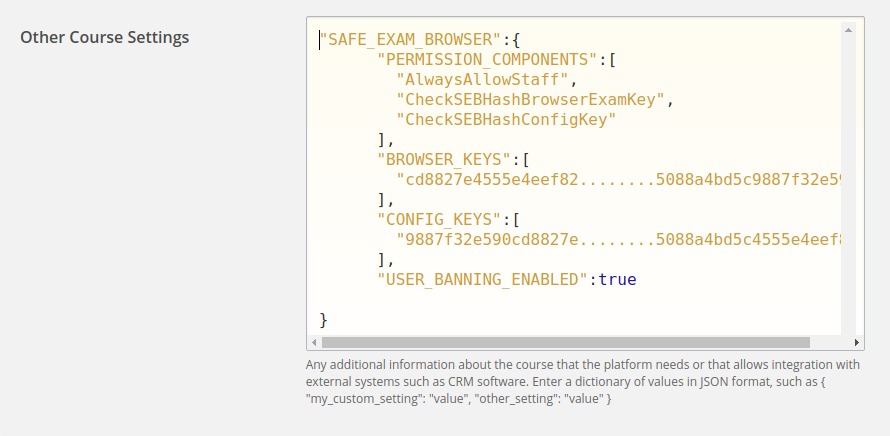
You could optionally use the course key as well
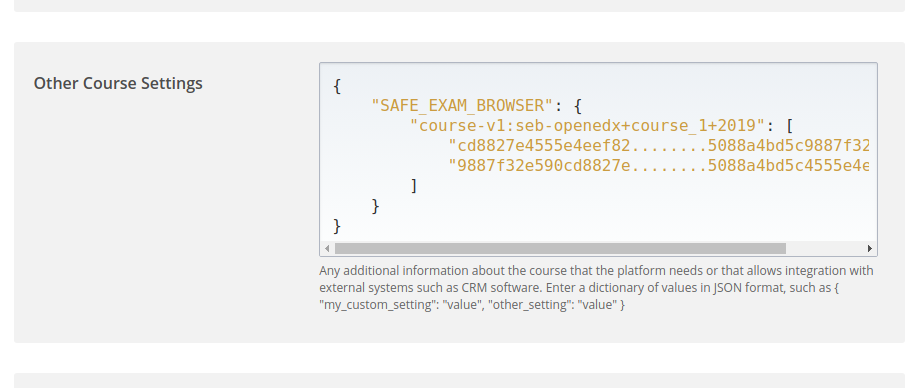
Site Configuration in the admin
from_site_configurationOn the site configurations you can add a key
SAFE_EXAM_BROWSERto the sitevaluesand inside of it, a dictionary with objects containing the<course_id>and configurations. Very similar to thefrom_global_settings.Here is an example with the same configuration as before:
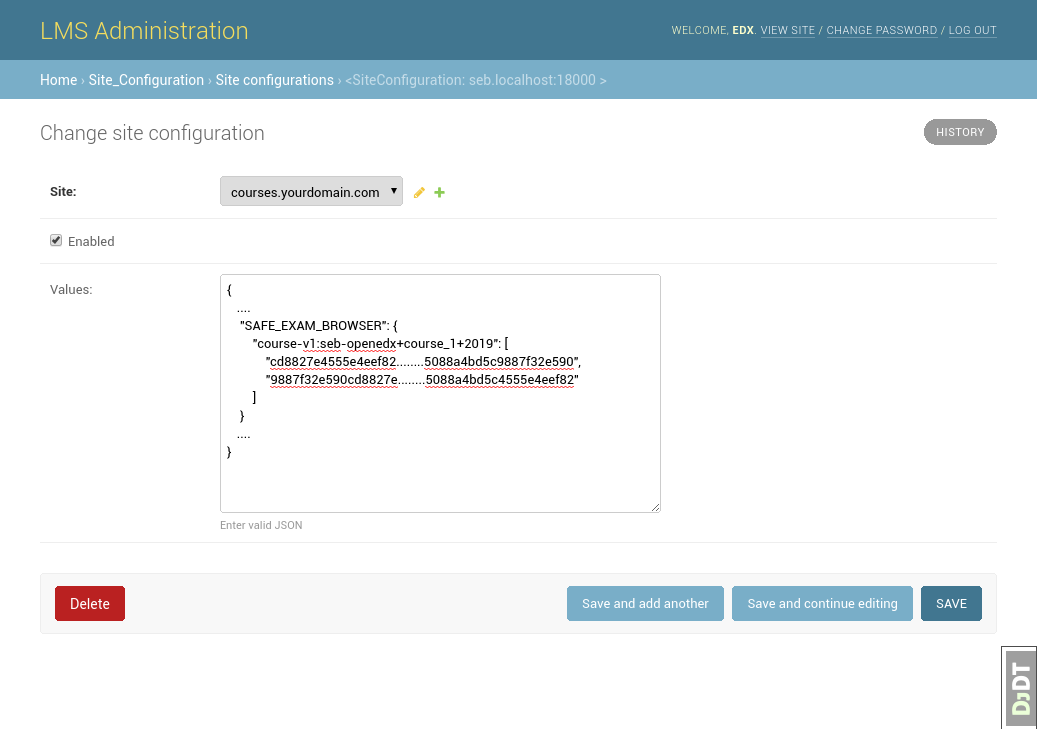
Note
The site configuration module uses a cache to improve the read performance for succesive reads. Unlike other caches in the platform that use memcached, this is a local thread cache that is implemented in the django-crud package.
When you change values in the site configuration object, the easiest way to break the cache is to do a process restart.
make lms-restartModel Configuration in the admin
from_django_modelAdd the settings using a line break between them.
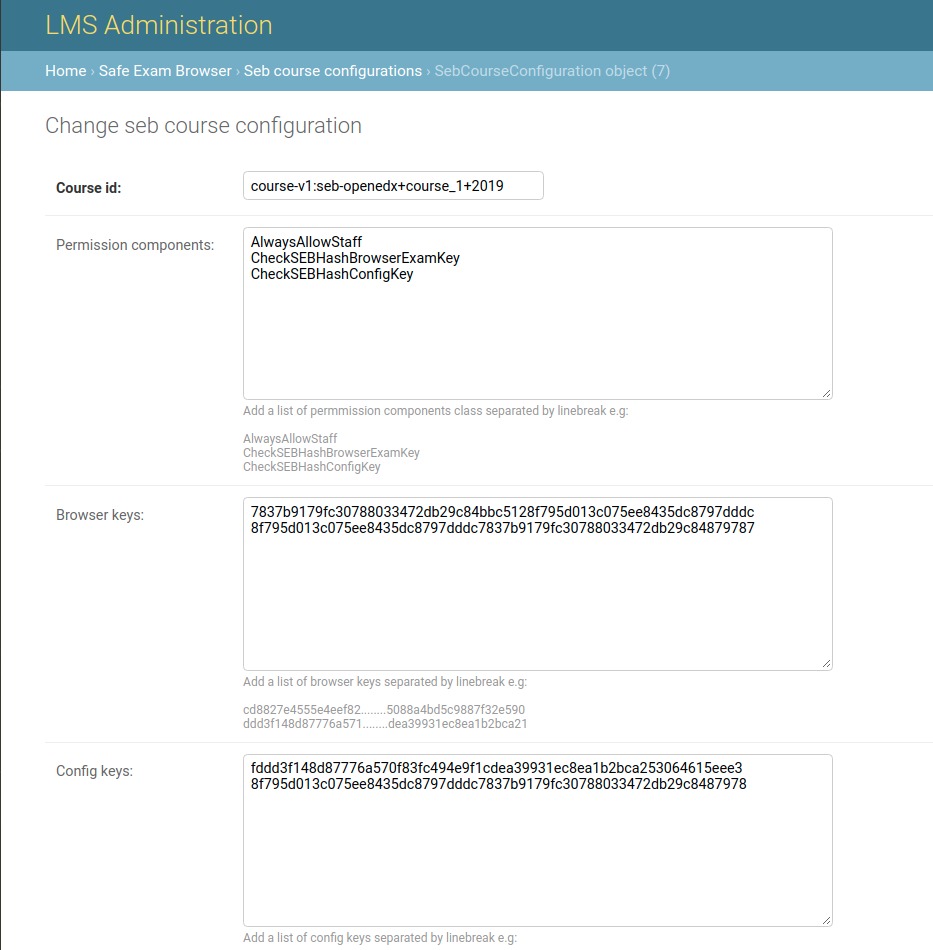
Note
It is required to run the migrations.
Advanced usage¶
The basic usage of the SEB Open edX plugin grants or denies access to a complete course. This means that every page of the course will be blocked for access without the configured Safe Exam Browser.
More advanced users can make use of the Path Whitelisting and Chapter Blacklisting options to provide a more flexible approach.
Path Whitelisting¶
As we mentioned before, the default of a course requiring a given SEB Key for access is to be completely blocked.
Now, some pages of the course might not require such a restriction. For those you can grant access even without the Safe Exam Browser by using the WHITELIST_PATHS list.
"course-v1:seb-openedx+course_1+2019": {
"BROWSER_KEYS":[
"cd8827e4555e4eef82........5088a4bd5c9887f32e590"
],
"CONFIG_KEYS":[
"9887f32e590cd8827e........5088a4bd5c4555e4eef82"
],
"WHITELIST_PATHS": ["wiki", "about"]
}
This will grant access to the course wiki and the external course about page even without the special browser or configurations.
Some important paths that can be whitelisted are:
"about""course-outline""courseware""discussion""progress""wiki"
Chapter Blacklisting¶
In the previous section we mentioned that "courseware" can be whitelisted. This would grant a user complete access to the course content thus defeating the purpose of the SEB Open edX plugin. For this the Chapter Blacklisting allows you to mark specific chapters for secure access.
Here it is worth noting that the naming convention is used differently in the user visible pages and in the code.
Code
Both the Code and the OLX or Open Learning XML use a hierarchy composed of course > chapter > sequential > vertical. This is the convention used for development here.
Studio
On Studio, the exact same hierarchy is composed of course > section > subsection > unit.
This means that a chapter is the same a a section and a sequential the same as a subsection.
Example:
"course-v1:seb-openedx+course_1+2019": {
"BROWSER_KEYS":[
"cd8827e4555e4eef82........5088a4bd5c9887f32e590"
],
"CONFIG_KEYS":[
"9887f32e590cd8827e........5088a4bd5c4555e4eef82"
],
"WHITELIST_PATHS": ["wiki", "about", "courseware", "course-outline"],
"BLACKLIST_CHAPTERS": ["e87b8744ea3949989f8aa113ad428515"]
}
You will find the ID of the chapter in the URL

For instance if your url is:
https://courses.yourdomain.com/courses/course-v1:seb-openedx+course_1+2019/courseware/e87b8744ea3949989f8aa113ad428515/10ddf7ff3a0a4e2f80c8838528e8c93e/1
Your chapter ID is:
https://courses.yourdomain.com/courses/course-v1:seb-openedx+course_1+2019/courseware/<CHAPTER_ID>/10ddf7ff3a0a4e2f80c8838528e8c93e/1
Which means your chapter ID is e87b8744ea3949989f8aa113ad428515.
As always you can use a list of IDs for multiple chapters.
Note
Currently only chapters are supported for blacklisting. Support for sections or verticals might come in the future.
User Banning¶
The user banning feature allows the administrator of a course to permanently ban a user from access if the user has attempted to access with a different browser of an incorrectly configured SEB.
This feature is by default turned off, but can be turned on either on the global Plugin Settings with the SEB_USER_BANNING_ENABLED key or per course on the Access Settings using the USER_BANNING_ENABLED key.
When a user has been banned, a message will appear on the page saying that the user is banned and that the teacher or systems administrator can assist them.

When this happens, a staff member can unlock the user by navigating to the seb-openedx dashboard.
It is located at: https://courses.yourdomain.com/seb-openedx/dashboard/
